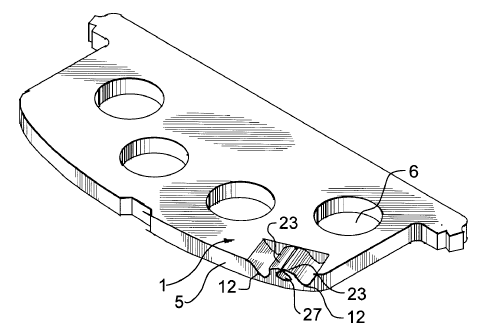Some of the information on this Web page has been provided by external sources. The Government of Canada is not responsible for the accuracy, reliability or currency of the information supplied by external sources. Users wishing to rely upon this information should consult directly with the source of the information. Content provided by external sources is not subject to official languages, privacy and accessibility requirements.
Any discrepancies in the text and image of the Claims and Abstract are due to differing posting times. Text of the Claims and Abstract are posted:
| (12) Patent: | (11) CA 2220796 |
|---|---|
| (54) English Title: | METHOD OF MANUFACTURING A DISC BRAKE BACKING PLATE WITH AN EDGE HOLE |
| (54) French Title: | METHODE DE FABRICATION DE PLATEAUX DE FREINS A DISQUE MUNIS D'ORIFICES EN ANGLE |
| Status: | Expired |
| (51) International Patent Classification (IPC): |
|
|---|---|
| (72) Inventors : |
|
| (73) Owners : |
|
| (71) Applicants : |
|
| (74) Agent: | BERESKIN & PARR LLP/S.E.N.C.R.L.,S.R.L. |
| (74) Associate agent: | |
| (45) Issued: | 2002-07-02 |
| (22) Filed Date: | 1997-11-12 |
| (41) Open to Public Inspection: | 1999-05-12 |
| Examination requested: | 1997-11-12 |
| Availability of licence: | N/A |
| (25) Language of filing: | English |
| Patent Cooperation Treaty (PCT): | No |
|---|
| (30) Application Priority Data: | None |
|---|
A method of manufacturing a disc brake backing plate with an edge hole which comprises the steps of first forming two substantially parallel grooves on the outer surface of the backing plate to define a raised section between the grooves. A channel is then formed within the raised section to define two ridges bounding the channel. Finally, the ridges are bent toward each other to define the hole.
Un procédé de fabrication d'une plaque de support de frein à disque avec un trou de bord qui comprend les étapes consistant à former tout d'abord deux rainures sensiblement parallèles sur la surface extérieure de la plaque de support pour définir une partie surélevée entre les rainures. Un canal est ensuite formé dans la section surélevée afin de définir deux nervures délimitant le canal. Enfin, les nervures sont courbées l'une vers l'autre pour définir l'orifice.
Note: Claims are shown in the official language in which they were submitted.
Note: Descriptions are shown in the official language in which they were submitted.

For a clearer understanding of the status of the application/patent presented on this page, the site Disclaimer , as well as the definitions for Patent , Administrative Status , Maintenance Fee and Payment History should be consulted.
| Title | Date |
|---|---|
| Forecasted Issue Date | 2002-07-02 |
| (22) Filed | 1997-11-12 |
| Examination Requested | 1997-11-12 |
| (41) Open to Public Inspection | 1999-05-12 |
| (45) Issued | 2002-07-02 |
| Expired | 2017-11-14 |
There is no abandonment history.
Note: Records showing the ownership history in alphabetical order.
| Current Owners on Record |
|---|
| NUCAP INDUSTRIES INC. |
| Past Owners on Record |
|---|
| ARBESMAN, RAY |